#all of this is alchemical allegory
Text


An angel. Alchemy treaty Aurora Consurgens, 1420-1450
#medieval redraw#alchemy#angel#manuscript illumination#My interpretation of the general iconography is probably very off so take it purely as an aesthetic pursuit lol#all of this is alchemical allegory#i recommend looking up the other weirdo miniatures from this manuscript it slaps
17K notes
·
View notes
Note
Oooo can’t wait to see the continuation of odd ducks kidnapping. I hope you don’t mind if I suggest something like odd duck was able to sneak away and hide from the kidnappers and Bruce and Clark find her.
"It's Allegory!"
"Preposterous! Hundreds of years of study for an extended metaphor?"
You shrug and look at the array of Alchemical tools that had been laid out, "How many people are still arguing about the existence of Aliens when we live in a time when they're real?"
The shock from the cattle prod catches you by surprise and you cry out, the tape cutting into your wrists and ankles as you jerk against it. "You're the expert," he snapped. "And if you want to make it out of here alive you'll produce an elixir."
"You realize that I could just fake it and you'd die testing it, right?" you put in dryly.
Another shock. And this time you bit your lip hard enough for it to bleed. The copper and salt tang of warm blood pouring into your mouth making you cough.
"The Elixir!" he demanded. "You've seen the formula. I know you have."
"Seen doesn't mean I can replicate-" Another shock cuts you off and you're left gasping. The bindings cut your wrists and it's all you can do to keep from whimpering as you sag against the chair.
Lead. This place was lead-lined or Clark and Lois were deep into enjoying a weekend alone- fuck. If someone didn't hurry up not only were you probably going to piss yourself if they didn't quit shocking you but, you were going to have to convincingly replicate a concoction to help some dumb shit conspiracy theorist live forever... If Clark told your mother about this you'd kill him. The last thing you needed was an "I told you so" lecture about something so absurd she could have never imagined it.
164 notes
·
View notes
Text
Angeology - Michael trough the eyes of artists
The second most common motif is Michael on Judgement Day, holding scales in one hand and a scroll - the book of life in the other, where souls of the damned depart at the right hand of God to the kingdom of heaven, the damned descend at his left hand to hell, where the second death awaits them after suffering doomsday. The Judgement Day was also depicted as sunset, night is born at the end of the path of the sun. Some cultures and religions believed that death reigned in the west because the sun went there to die. Michael, more precisely, is the angel of resurrection, he gives every soul the opportunity to redeem themselves from evil before death, turn their souls into gold in alchemical allegory. (some cultures uses it as an idiom - golden hands or heart of gold)
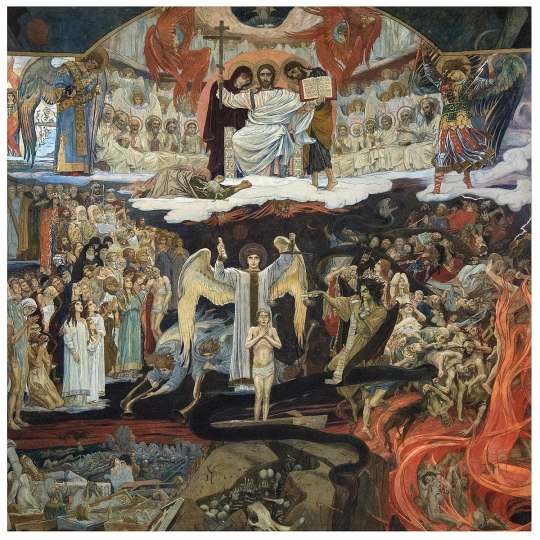
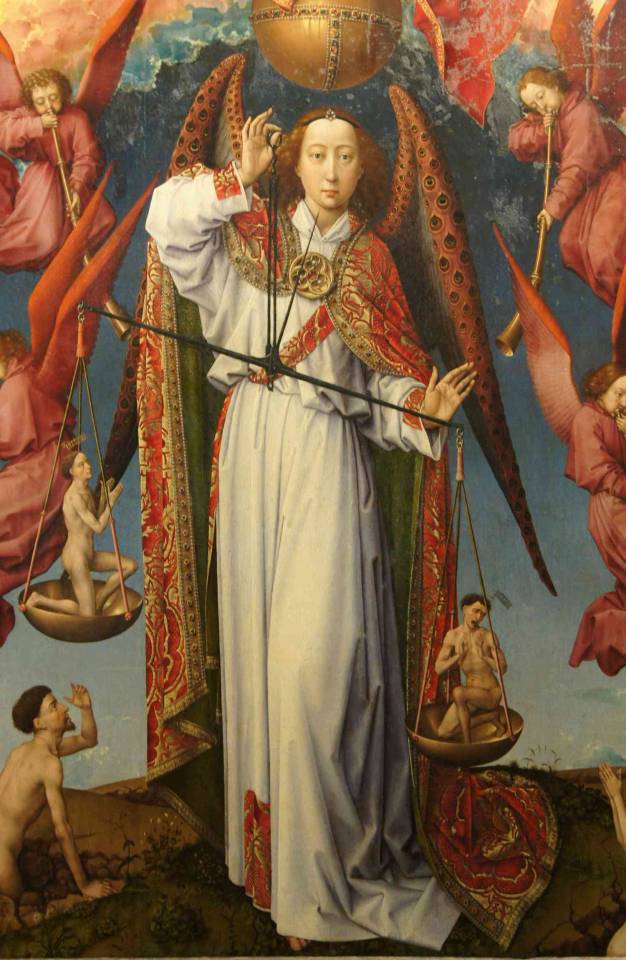
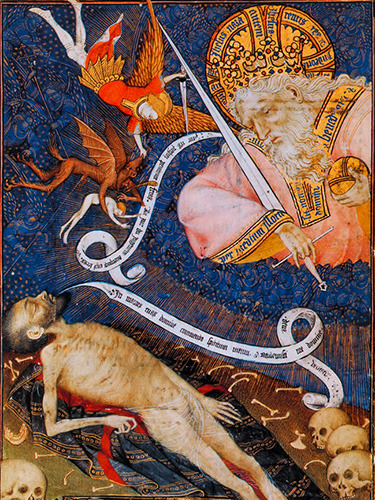
In the role of the guide of the souls, Michael follows the pre-Christian cult of the sun, the Greek Hermes, the Celtic god of sun - Lug, the Roman Mercury etc..

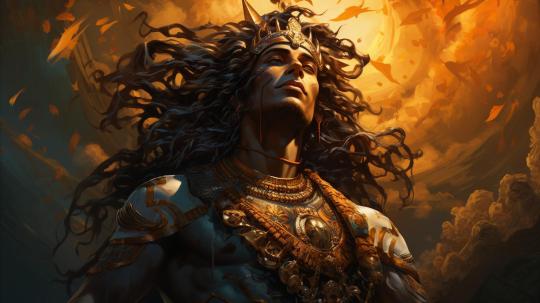
According to Bonaventure , Michael was a seraph and an angel who guards the gate of paradise with a flaming sword. Which council does Michael belong to? Not even theologians are sure. Author categorizes Michael to eighth angel choir.
(OP note: I attended one of Authors lectures - When I write "the reference/book/bible author chose" - it wasn't his uninformed choice. Author was and is deliberately discussing the discrepancies with theological authorities, but unfortunately they couldn't give him a direct answer either - nor commit to one notion! In order to not postpone his study, Author decided to go along one particular notion/bible/reference and followed it throughout the books. Do not be concerned about theological vocabulary, it all started by statistics, but as statistic is full of numbers only and no pictures, it is very boring. Also, as I am reading trough this tomb as we go along, I cant say now if Author devoted full chapter to the statistic alone. This is the third book, there is the first one, which, probably, explains the math thing, but oh yeah, I have to start somewhere so why not at contemporary archangel. Return to Authors words-)
Michael displaces the God of Sun so perfectly, that the caves of the sun gods have turned into places of pilgrimage.
The author also talks about many civilizations that associated the sun with the figure of the judge, as the embodiment of law and justice. Michael was often depicted as a fighter against the Evil.
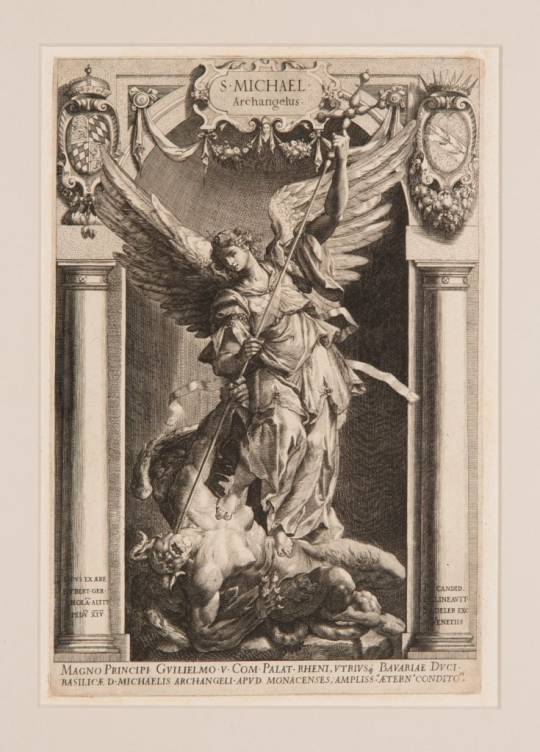
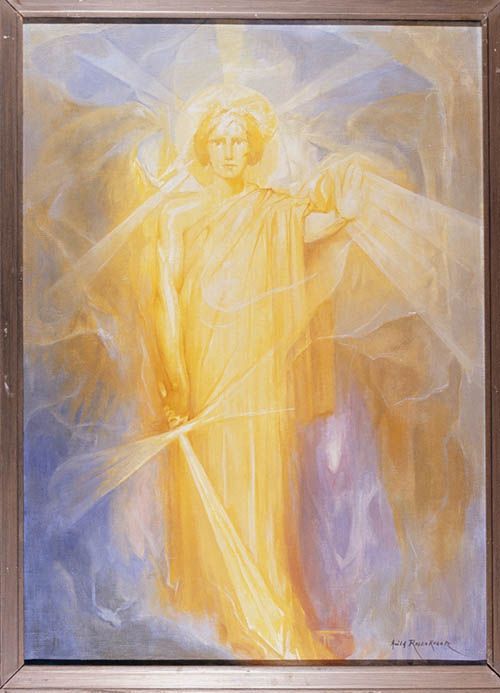
(Not a wonder, that when you google Michael and Dragon, you'll get something over 680.000 hits. Some of them are actually titled Michael and the Serpent. That Michael was deemed a protector, it is confirmed in the bible, where most of the artists drew inspiration from. It is important to mention that in these times only the gentry and the church had money to patron the art, or at least was not ashamed to show the plenty of it.)
For Good Omens fanbase: Author once connects Michael with Metatron and uses Persian painting as an example. Not under my watch.

17 notes
·
View notes
Text
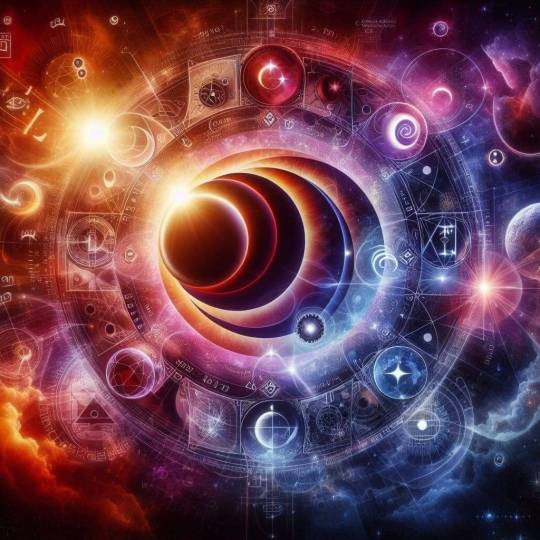
The Eclipse
Embarking on a discourse that endeavors to transcend human comprehension requires us to step beyond the veil of conventional understanding, into a realm where the phenomena of eclipses are not merely celestial events but cosmic symphonies with profound esoteric and metaphysical implications.
At the inception of cosmic time, the orchestration of celestial bodies was set into motion, laying the foundation for the occurrence of eclipses. These celestial events, marked by the alignment of the Earth, Moon, and Sun, are not mere happenstances but intricate cosmic dances that reflect the underlying order and harmony of the universe. Herein lies the first layer of understanding—an appreciation of the physical mechanics governing eclipses, revealing a universe bound by precise laws, where every shadow cast and light obscured is a note in the grand cosmic score.
Beyond the realm of physical laws lies the mystical significance of eclipses, as perceived through the lens of Kabbalah. In this ancient wisdom tradition, an eclipse is not just a shadow but a divine concealment, Tzimtzum, where the Infinite Source momentarily withdraws its light to invite deeper reflection and spiritual awakening. This act of divine contraction mirrors the soul's journey through the realms of concealment towards the ultimate revelation of Ein Sof, the boundless light, teaching us that darkness is but a path to enlightenment.
In the Gnostic tradition, eclipses serve as powerful metaphors for the soul's entrapment within the material world—a world veiled by the illusion of Maya. The transient darkness of an eclipse symbolizes the potential for the soul to pierce through this illusion, to remember its celestial origins, and to embrace the liberating knowledge that transcends the physical confines of existence.
Drawing from the ancient wisdom of Egypt, the journey of the sun god Ra through the underworld during an eclipse becomes a profound allegory for the cycles of death, rebirth, and eternal life. This celestial phenomenon embodies the perpetual struggle against chaos and the triumph of light, mirroring the human quest for order, harmony, and transcendence.
The Vedic perspective views eclipses as pivotal cosmic events that significantly influence the flow of karma and the unfolding of dharma. These moments of celestial alignment are seen as gateways to profound spiritual energy, offering opportunities for introspection, purification, and alignment with one's higher purpose, thereby navigating the soul through the intricate web of cosmic law and order.
Venturing into the realm of speculative esotericism, eclipses are envisioned as focal points in the fabric of the multiverse, acting as cosmic keys that unlock interdimensional gateways. This perspective suggests that during eclipses, the veils between worlds thin, vibrations shift, and channels of communication with higher intelligences open, offering glimpses into the interconnectedness of all existence.
In the shadow of an eclipse, we encounter the Shamanic journey of soul retrieval, where the darkness serves as a portal to other realms. Here, the eclipse becomes a ceremonial time for healing, for venturing into the depths of the soul's shadows, and for reclaiming lost parts of oneself. It is a profound reminder of the cycles of loss and recovery that define the spiritual journey.
Alchemy, too, finds in eclipses a symbol of the magnum opus—the great work of transforming the base metals of our being into spiritual gold. The interplay of light and darkness during an eclipse mirrors the alchemical processes of dissolution and coagulation, guiding the seeker through the stages of spiritual transformation and enlightenment.
From the perspective of quantum mysticism, eclipses are moments when the fabric of reality becomes malleable, when the potential for quantum leaps in consciousness is heightened. They are seen as temporal nodes where the probabilities of existence converge, offering unique opportunities for manifesting new realities and transcending linear time.
In the realm of astrology, eclipses are considered powerful omens that herald significant life changes and shifts in collective consciousness. They mark moments of destiny's acceleration, where individual and collective karma unfolds at an intensified pace, inviting us to align more deeply with our soul's purpose and the evolutionary currents of the cosmos.
The Tarot, with its rich symbolic language, associates eclipses with the Major Arcana cards of The Sun, The Moon, and The Tower, reflecting the themes of illumination, intuition, and sudden transformation. In the context of an eclipse, these archetypal energies invite us to embrace revelation, to listen to the whispers of the subconscious, and to navigate the upheavals that lead to spiritual renewal.
The Sufi mystics perceive eclipses as divine invitations to experience the annihilation of the self (fana) and the union with the Beloved. The temporary obscuring of the light is seen as a moment to dissolve the ego, to enter the dark night of the soul, and to emerge with a deeper realization of oneness with the Divine.
In the Hermetic tradition, "As above, so below" finds profound expression during eclipses, as these celestial alignments are understood to reflect and influence the microcosm of the human soul. Eclipses become moments of magical potency, where the correspondence between the heavens and the earthly realm can be harnessed for spiritual growth and transformation.
Through the lens of Depth Psychology, eclipses symbolize the confrontation with the Shadow, the unacknowledged and repressed parts of the psyche. They offer a powerful opportunity for shadow work, for integrating the dark aspects of ourselves, and for achieving greater wholeness and self-awareness.
Finally, in the collective consciousness of humanity, eclipses stand as universal symbols of awe, wonder, and the quest for meaning. They remind us of our shared humanity, our common gaze towards the heavens, and our eternal search for understanding in the vast, mysterious expanse of the cosmos.
In weaving together these multifarious strands of knowledge, wisdom, and speculation, this lecture aspires to illuminate the profound and manifold significance of eclipses—a cosmic phenomenon that bridges the physical and the metaphysical, the known and the unknowable, inviting us to explore the depths of existence and to contemplate our place within the infinite dance of the universe.
10 notes
·
View notes
Text

To The Tantric Cats Who Noticed,
Slay the red dragon- sexual energy- with a sword- human will- and bring that raw animal energy higher. The phoenix is born- alchemical kundalini rises. You see the symbolism.
Study St George, Apollo, Hermes, Krishna, Siegfried- anyone who slays a serpent and you’ll find the allegories about overcoming the beast within and the tantric significance.
I think the Golden Legend has an account of St. George but it’s written to convert people so be leery. Jung ties Hatha-Yoga and the alchemical processes together in several of his works. They’re actually the easiest texts for westerners to read too.
The golden candlesticks of Hosea tell of this same process but with all the cryptic symbolism you’d expect of the prophets.
The method is the restraint of releasing sexual energy. Classical Hinduism as several methods of doing this.
#tantric alchemy#inner transformation#phoenix rising#slaying dragons#kundalini#alchemy#cg jung#mercury#st george#allegory#symbolism
43 notes
·
View notes
Note
I meant strictly that Dave cutting the katana and Roxy killin HIC with it were good choices item-wise. Katana I think I explained thoroughly. As for sword, Dave had an entire thing about him not being a hero, being imperfect and all. That connected to him breaking swords instead of pulling them out as hero would have done. He used to feel depressed about this as he idolized people around him, but he cut the katana by his own choice - broke an unbreakable sword knowing that would result in bad stuff (dirk's death (beheading was just a meme imo and abusive brother stuff is a bunch of crap though)), but decided conciously not to be a hero, accepting his imperfection, which won him the battle in the end. It's more of a metaphor, not an allegory, so I understand some might have differing opinions, but for one thing I think it gave Dave a good closure.
I would like to think that he can be a hero. To be able to stand along side his friends. His friends used to idolize him as a cool kid, then Dave would look up at people like John and Jade, who are doing these amazing things in their planets on Sburb. It would make more sense for all of them to rise together and show how their friendship really stood the test of time throughout the whole series. The separation of them upon Act 6 just kills it. Worse is having Post Retcon in mind too.
At best, one stab shouldn't be enough to kill HIC immediately, even if said name is Unbreakable Katana. The fight scenes on her were awesome, but the katana only seems to be done the final blow compared to the other attacks. It would make more sense if the sword alone was the most used during the fight, but it's not the case as we see in [S]Collide with how most are using God Tier powers and alchemized weapons.
I still to this day think the true fight with the HIC should have been with people like Karkat, Kanaya, Terezi, and Vriska. To really give that final closure for the Ancestors that the series had built up. With Karkat being the one to get that kill to give peace to the Signless/Sufferer and make a better future for a new generation of trolls. But I suppose if someone like him was thinking he would be a Threscutioner despite his mutant blood, maybe he doesn't mind the oppressive system that was placed on him. You just got to work hard to not end up being culled.
2 notes
·
View notes
Text
The first principle and lore basis of Ephmyvology demands of us all as students to accept that:
We Locked Some Terrible Thing In The Basement Last Week.
(and forgot all about it and cannot recall the details of such an event)
and we also have to reconcile that with the fact that this has been the basis for all Ephmyvologists for decades.
This either means:
1. The Individualist Amnestic Theory:
Becoming an Ephmyvologist involves spawning some sort of Thing from within you and then locking it away in the basement with the help of others (and that we all take alchemical concoctions to forget about it.) This means that there are actually a lot of terrible things in god knows which underground chambers. That might explain all the disappearances lately. oh god.
2. The Metaphorical Allegory Theory:
"Last Week" is not actually fully accurate, but that knowing exactly when whatever was sealed away would be Very Very Bad for some reason. Same thing for "We" - the we in this case instead is a stand-in for whatever ancient order of Ephmyvologists (well, Geromyvers probably but whatever) sealed away whatever the terrible thing is. Probably some sort of ancient evil. And being an Ephmyver means that we need to act like/assume that said ancient events are due to us and that we had a part in them.
3a. The Fake History Theory.
"Last Week" is accurate, but the entire past of Ephmyvology being an at-least decades-old art is fabricated. Whether or not the fake history charade is an essential part of Keeping Ephmyvology Working or not is anyone's guess, but we're not going to take the risk and find out.
3b. The Secret Time Travel Theory:
"Last Week" is accurate and Ephmyvology is actually ancient. This means that at some point time travel will be developed by an Ephmyver and spread to the distant past somehow. Because obviously this would happen if one of us invented a time machine. Maybe the Thing we locked away is actually just the time travel device. No You Can't Just Go Look In The Basement.
5. Denialism:
There actually is no Terrible Thing in the basement and we didn't lock it away in there last week. But we need to assume that we did In Order For Ephmyvology To Work.
4 notes
·
View notes
Text
It is really interesting tracing where Jungian storytelling (as a conscious form) emerges so organically:
All the mythologized processes of nature, such as summer and winter, the phases of the moon, the rainy sea sons, and so forth, are in no sense allegories of these objective occurrences; rather they are symbolic expressions of the inner, unconscious drama of the psyche which becomes accessible to man's consciousness by way of projection—that is, mirrored in the events of nature.
That's just describing narrative. Even if you don't go along with his conception of the psyche or psychonalysis in general, that's literally just the way narrative works.
(From Collected Works of C. G. Jung, Volume 9, Part 1: Archetypes and the Collective Unconscious).
Of course, analyses of unconscious Jungian storytelling is kind of another matter altogether. Most of the sources I've looked at over time (like analysing Greek tragedy through Jung) have only ever been about unconscious employment of Jungian storytelling, but the bit I'm specifically trying to untangle - in my clumsy fashion - is when storytellers use it in a conscious way (e.g. The Last Jedi, most recently and in a major production, or something like Dark) as a conscious narrative/character structure (or as a way of representing characters' psyche... so in other words, conscious use).
I have a source on reading Jung and Campbell together so I'm looking forward getting into that next, because they're so obviously linked (so much of Campbell is grounded in Jung), though I'm less clear on the alchemical storytelling (alchemical/Jungian/monomyth are all kind of linked) but it's not really in my wheelhouse beyond looking at the alchemical dictionary lol.
Anyway, this is part of a bigger post on R/WBY and Jung, and ofc I want to instantly become a Jungian scholar overnight which is impossible. I would at least like to be somewhat confident with the topic, and familiar enough to describe what I think is within the reasonable reach of the story.
Of course, what is complicated at hand here is that in my academic studies neither Jung nor Campbell are actually that serious methods of the study (the latter much moreso; Campbell doesn't really figure into the academic world of archaeology at all, if anything he's sort of taboo) and differentiating between that and the narrative use of them is also somewhat of a mental task. I do think there was a bit of baby and bathwater moment with psychology and psychoanalysis, but this is less true of Campbell (in that case, he's working with limited sources and limited source analysis, so from the get-go his work is academically impaired). Particularly because in many ways Campbell is more about self-help or self-actualisation than is he an archaeological scholar.
1 note
·
View note
Note
Hey, there! I hope you're having a good day so far. I saw a page you posted the other day with alchemy symbols on it. I'm looking to read more about alchemy, specifically it's tie to witchcraft, and I thought I would ask you if you know of any good places to start. Thanks so much for all the resources you share! 💜
Hi,
The way alchemy ties into my witchcraft is that I use the planetary symbols and the cosmos in my magic. Also I use the alchemical planetary hours in spells and talismans.
When I’m making potions or flying ointments I’ll sometimes consult the book the herbal alchemist handbook by keren Harrison. There’s a lot of books on the subject of herbal alchemy that can be useful in incorporating it into your witchcraft.
I also enjoy learning about and using magical symbols in my practice like with sigil making. And the alchemical subjects are often allegory and represent something else. For example the philosophers stone is enlightenment.
Happy casting!
-Darkest
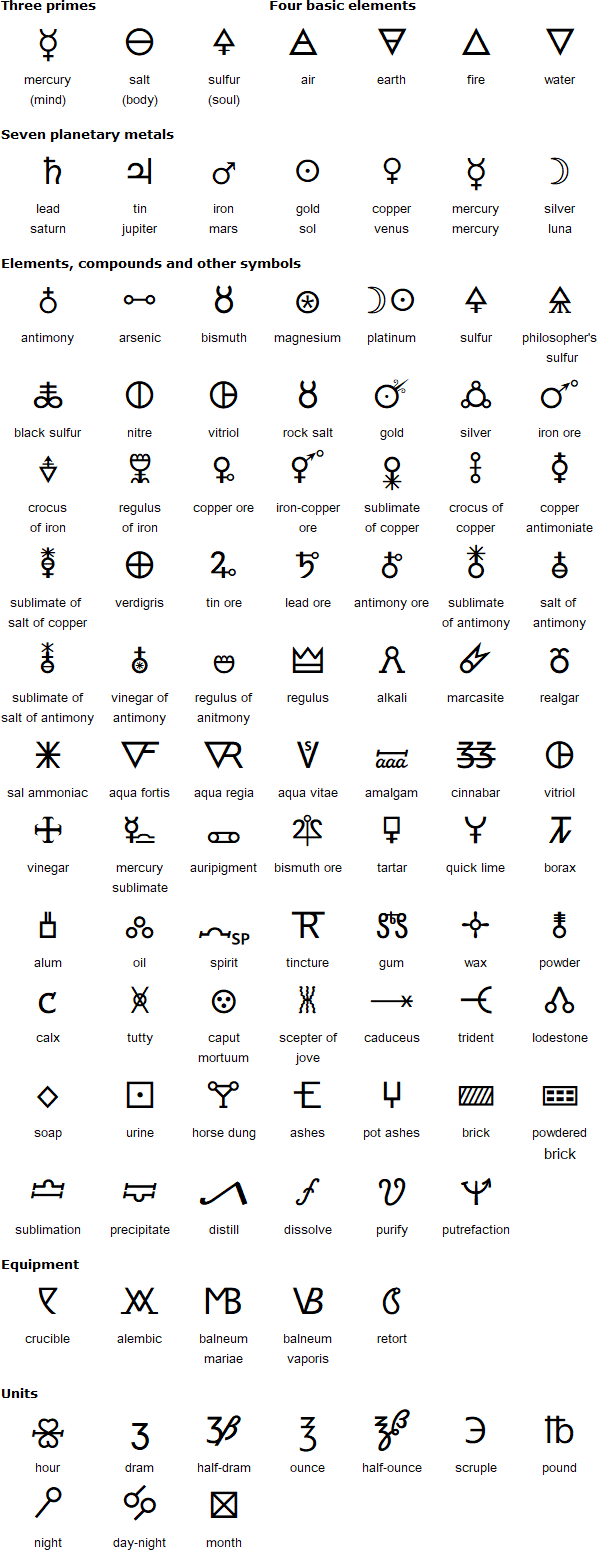
89 notes
·
View notes
Text
RWBY and the Philosopher’s Stone
So, I finally watched RWBY after a friend name-dropped several characters and I was like wait... those names are alchemical. I was still pleasantly surprised to find out just how deeply rooted in alchemy the story is, from its characters to its plot structure.
Background: alchemical structure is a type of story structure that focuses on inner transformation via outward obstacles. You can find it in literary traditions across the world, from Moxiang Tongxiu’s novels to A Song of Ice and Fire to Harry Potter to The Witcher to Trollhunters. Carl Jung incorporated it into his psychology. Daoism plays heavily into Chinese alchemy. The Wizard of Oz, one of RWBY’s main inspirations, is a blatant alchemy allegory. It’s everywhere, so it’s not surprising RWBY is drawing heavily on alchemy, but it is neat to see how blatant the references are.
Thematically, the goal of alchemy is a metaphorical philosopher’s stone. The philosopher’s stone, in legend, is said to produce an elixir of eternal life, and to be able to transform “baser” metals into gold.
In stories, when positive, as it usually is, this usually results in a character either overcoming death (see, Harry Potter) and/or transforming the world and others around him (Harry Potter saving his friends, etc.) But the journey from how they get from prima materia (raw material) to the philosopher’s stone? Now that’s the story.
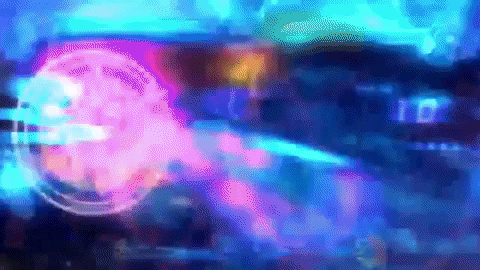
(When reversed, a metaphorical stone results in something that can destroy everything; see: the One Ring, also Salem, because Salem’s whole thing is that she cheapened the process of life and death, while alchemy states that death is a necessary part of achieving life.)
So, mostly I’m gonna talk about the symbolism I’ve seen so far and make some predictions for what’s likely to happen next in the story, and for the characters.
Each of the four main characters has a name that corresponds to one of the four phases of the Magnum Opus. “Blake Belladonna” refers to the nigredo, or black stage; “Weiss Schnee” to the albedo, or white stage; “Yang Xiao Long” to the citrinitas or yellow phase, and “Ruby Rose” to the final stage, rubedo, or red (Ruby’s name is quite literally taken from that stage). Naming them for these stages shows a dual purpose: while Ruby is the central character, she needs her team around her, and Team RWBY will save the world together. Team JNR is also a part of the stages, but I’ll get to what they represent later on.
Jung associated each of the major stages with a major archetype. The major stages can be further broken up into a total of seven or twelve or even fourteen stages. Most commonly you’ll see George Ripley’s Twelve Gates referenced, and I believe that’s what RWBY is referencing as well since its allusions are pretty perfect. The "gates” or stages also sometimes overlap, especially when different characters might be at different stages.
Nigredo: Seasons 1-3
Alchemy begins by gathering the prima materia, or raw material. The characters assembling in season 1 is more of the gathering than the actual transformative process. But once we hit season 2, we dive straight into the process.
Calcination occurs during the climax of season 2, during the fight on the train. Season 3 contains dissolution, or the washing of impurities through the exposure of certain secrets (like the fall maiden) as well as the literal dissolution of Beacon Academy, and separation (the end of the season, when Team RWBY is scattered).
Narratively, Jung associated nigredo with the shadow, with someone’s dark night of the soul, their low point. In historical artistic depictions, often part of nigredo is dismemberment... which happens to Yang when she saves Blake from Adam. See, Splendor Solis:
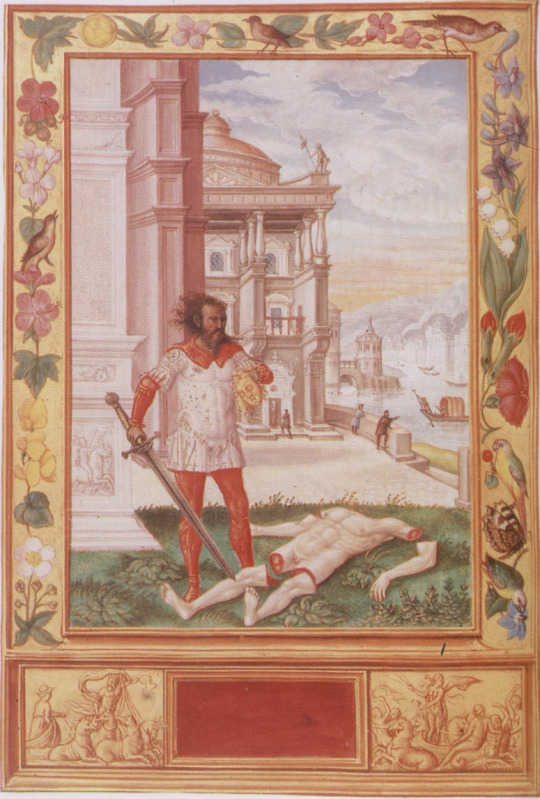
The goal of the shadow is that it should be integrated with, accepted, rather than denied. Facing the shadow is a necessary part of growth and ultimate transformation... and the point is, through facing the shadow, hope and light come.
Peacock’s Tail: Seasons 4-5
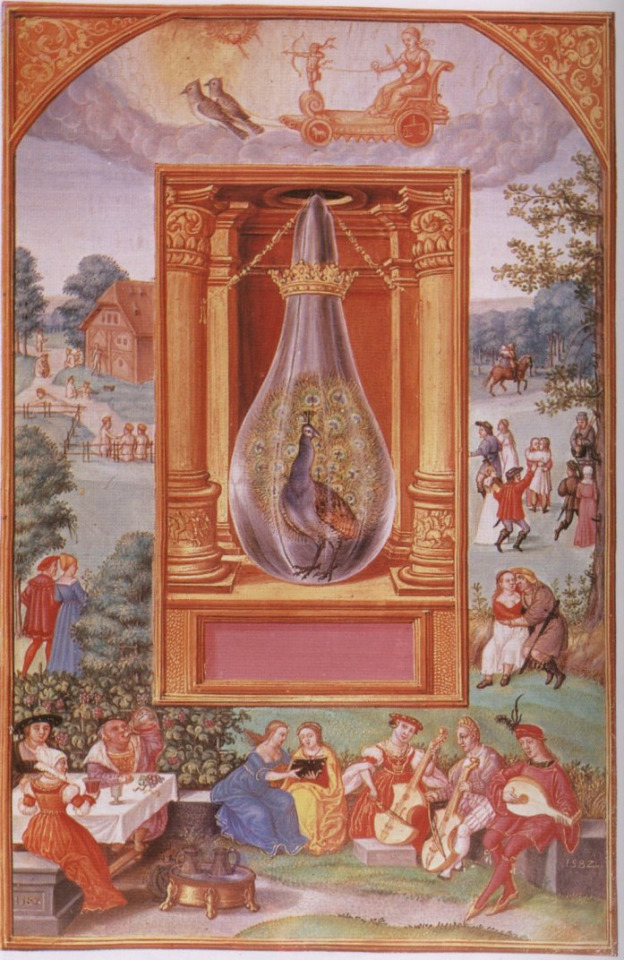
Okay, I lied, there are sometimes five phases in alchemy. At the very end of nigredo, just before albedo, there is sometimes a flash of light, of rainbows and colors, that give hope. It’s not quite a phase, more of a moment, but it’s referred to as the peacock’s tail. While this is less plot-related, it does make sense that this is the point in the story where Team RJNR is formed. Why? Because look at their colors:
Ruby: red, black
Jaune: yellow, blue
Ren: green, purple
Nora: white, pink, orange
Between them we’ve pretty much got the full rainbow.

We also have, in Blake’s arc, the introduction of Ilia Amitola, whose last name is the Souix word for “rainbow.”
Albedo: Seasons 5-7
Albedo is associated with the anima or animus, or the part of ourselves that we are lacking (it’s generally gendered as the male within a female and the female within a male, but please understand he’s not talking literally and more in terms of traditional qualities ascribed as feminine or masculine that we may repress), which more than fits the fact that this stage begins while team RJNR is literally wandering around a continent called Anima.
Conjunction is a term in which all the separated parts that can be salvaged from the Nigredo come together. Obviously the main incident for this is the fight at the end of volume 5, but I’d argue it overlaps a bit with volume 4 and even with separation.
The characters are only able to come together again once they’ve accepted aspects of their shadows. Yang deals with hers in Raven and Blake with the White Fang. Nora and Ren’s fight at their home village represents them dealing with their shadow as well, and also relates to conjunction because conjunction is the stage where the first chemical wedding comes into play. A chemical wedding is the joining of alchemical partners, and while I’ll probably discuss ships in another post (there’s a lot of set up alchemy-wise), I’ll just reference the obvious one here:
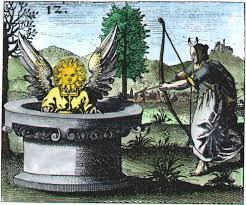
The fountain image and a person shooting arrows is some pretty uncannily similar imagery to the fight at Nora and Ren’s home village.
Next up in albedo is putrefication (focus on death and rotting). We see this with the encounter with the Apathy, who look like skeletons, cause death, etc. We’re also introduced to Maria Calaveras, aka the Grimm Reaper. (Her last name also means “skull” aka the white results of putrefication).

Congelation requires a lot of water, and we see this in the focus on Atlas, wherein snow (water) is everywhere. The point of congelation is to separate the thin from the thick, the latter of which will of course become the Philosopher’s Stone. We see this through Team RWBY’s break with the Ace-Ops (aka the Aesops), whose simplistic morality and rule-following are not going to bring about character growth or eternal life.
Citrinitas: Volume 7-?
Citrinitas focuses on the light, or fire. That immediately after congelation, a giant whale brimming with yellow appears in the white-colored Atlas is not a coincidence. Citrinitas is associated with the sage or the wise old man/woman, so Maria and Pietro fill this role.

The first stage of citrinitas is cibation, which involves feeding with fresh material. I’d actually say that it seems quite possible cibation overlaps with congelation, in that there is a focus on food and on training with the Ace-Ops early in Volume 7. The next phases are sublimation and fermentation. I can see potential for sublimation in that it essentially is when solid becomes air (think of the setting of Atlas), but it’s too soon to say what this means for the plot.
Fermentation, though... well, things will get worse before they get better. :’)
Rubedo:
Finally, Rubedo is associated with the fully individualized self. We can assume each of the main seven will come into their own, confident of whom they are. Oscar should, as well, and probably will have fully control over his body by the end (ie Oz will likely... find rest or whatever).
The stages of rubedo are exaltation (the creation of the stone after two contraries meet), multiplication (the stones’ properties increase), and projection (the stone’s abilities are projected over the entire world, aka presumably RWBY will save the world).
The most common way to display multiplication is through, well, a lot of couplings. It’s why the main characters ending single seems extremely unlikely to me. Even if it seems a fairy tale ending, well.... *gestures to everything about RWBY being inspired by fairy tales* Fairy tales were also often alchemy based. But ships will get their own meta, because I actually don’t really ship much besides Renora and am for once not super invested in anything, but I can see the set-up for four or five ships.
I also want to highlight the other symbolic names that stood out to me:

Ironwood. While I know Ironwood references the Tin Man in The Wizard of Oz (tin being one of seven metals associated with alchemy), his name also references a second metal: Iron. Tin and Iron are the two of the three basest metals in alchemy (the other is lead). Iron in particular is ruled by Mars, the god of war, meaning it is associated with violence. It’s not a coincidence that pretty much from the second Ironwood is introduced, the concept of war comes up, and his entire character has gone on to be the embodiment of the military and violence.
Tai Xiao Long. His name literally means “sun,” and Ruby’s mother is defined by her silver eyes (silver being a color traditionally associated with the moon). Ruby is thus considered the child of the Solar King and Lunar Queen, two mythical alchemical figures who together create the “Philosophical Child,” or the personified philosopher’s stone.


Pietro Polendina: his name literally means “stone,” and Penny is his philosopher’s stone. Penny is arguably a reference to copper, another of the seven metals, as copper references compassion and love, which seems like Penny to me.
Qrow and Raven Branwen: crows and ravens are symbolic of nigredo, or the black phase; death, decay, etc. However, within the story I think Qrow and Raven fulfill this role as the Jungian shadows of hunters as a whole and of Yang.
Sun Wukong: obviously a reference to the sun.
Emerald Sustrai: Emerald is a reference to the Emerald Tablet, which in alchemical lore is a tablet containing the secrets of alchemy, as written down by Hermes (in legend). Hermes is, of course, Mercury. Everything about alchemy stems from the Emerald Tablet, so Emerald should be important. In addition, green is the color of the prima materia, so it references Emerald’s arc in being shaped and molded by Cinder.

Mercury Black: Mercury as the mythological god is the legendary founder of alchemy, so like, he’s important. Mercury is also the third most important metal in alchemy, after gold and silver. It is necessary to achieving the philosopher’s stone so, like Emerald, Mercury is probably important. Mercury is of particular note because mercurial characters are common in alchemical literature: they make stuff happen. Think of Mercutio in Romeo and Juliet, for example. Mercury transcends death symbolically (you can see the roots of this in Mercury’s backstory with his assassin father): it is difficult to pin down and can quickly shift from liquid to solid. Thus, in alchemy, mercury can shift between life and death.
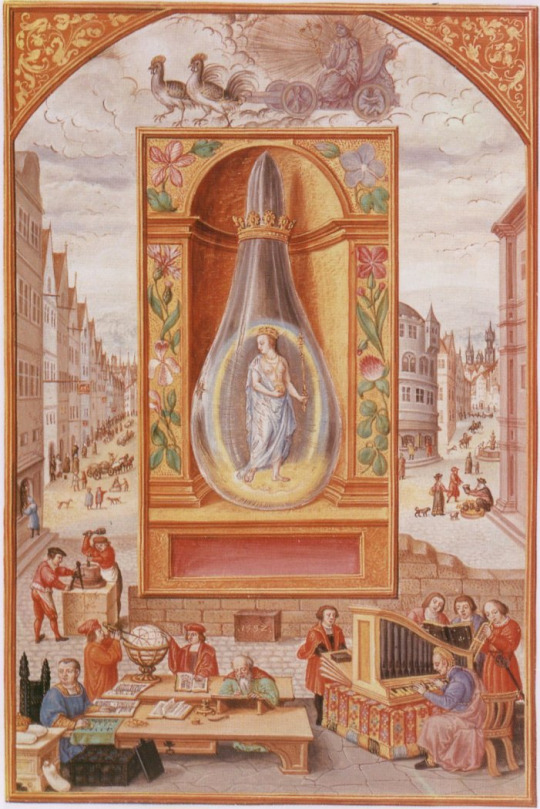
Mercury is also a noted servant of the white queen. I initially thought this a surface reference to Salem’s appearance, and it might be, but Salem is more associated with a black queen in the recurring chess motif, and I don’t see Mercury staying on her side (mercury isn’t fixed, after all; that’s its central tenet), so I kind of wonder if the “white queen” will be later revealed. Or maybe it just is a surface mention.
#rwby#rwby theory#rwby meta#rwby volume eight#rwby vol 8#ruby rose#weiss schnee#yang xiao long#blake belladonna#salem#tai xiao long#jaune arc#nora valkyrie#lie ren#mercury black#emerald sustrai#qrow branwen#penny polendina#pietro polendina#alchemy#jung#raven branwen#james ironwood
348 notes
·
View notes
Photo

𝗔 𝗬𝗲𝗮𝗿 𝗶𝗻 𝗙𝗮𝗶𝘁𝗵, 𝗗𝗮𝘆 𝟳𝟬: 𝗛𝗲𝗿𝗺𝗲𝘁𝗶𝗰𝗶𝘀𝗺
"As Above, So Below"
-Common paraphrasing of the 𝘌𝘮𝘦𝘳𝘢𝘭𝘥 𝘛𝘢𝘣𝘭𝘦𝘵
Hermeticism is a religious/philosophical tradition from which almost all extant forms of Western Esotericism and Occultism stem, at least in part. It is named after the fusional philosopher/deity Hermes Trismegistus.
𝗘𝘀𝗼𝘁𝗲𝗿𝗶𝗰 𝗢𝗿𝗶𝗴𝗶𝗻𝘀
Esoteric tradition are broadly defined by two features: secrecy and magic. The word “esoteric” comes from the Greek word for “inner” as in “inner circle”, and typically include a doctrine of knowledge which must be kept secret and only revealed to the properly initiated. The magical aspect of these traditions, typically what we would call “the occult” is often a result simply of the veneration of knowledge; the allure and power is what you can do with it. In the West, meaning Europe, Western Asia, and North Africa (all connected by the Mediterranean Sea), Esotericism was largely spawned by a newfound multiculturalism as the Roman Empire and other states began to erode in the first century of the Common Era. Before then most Mediterranean peoples would have generally practiced some version of either or both a state religion, like the Roman Imperial cult, and an ethnic one, like the pre-Christian “pagan” religions, both more expressions of nationality and heritage than philosophy. As state powers dwindled, cultural boundaries fuzzed and fusional philosophies began to form, not tethered to any one people or state. Originally, the restricting of esoteric knowledge was likely not due to any sinister conspiracy or defense against the state, but simply the fact that they could not be easily grasped without a basic philosophical education. Hermeticism developed in this period during the collapse of the Ptolemaic Kingdom. The Ptolemies were Greeks who took control of Egypt after the collapse of Alexander the Great’s empire. Though they adopted Pharaonic aesthetics to better appeal to the Egyptian populace, the Ptolemies maintained a sharp divide between the Greek culture of the ruling class and the conquered Egyptians. In the years leading to the collapse these boundaries at last blurred and the Greek and Egyptian traditions began to mutate in earnest. Thoth, the Ibis headed Egyptian god if writing, science, and magic, fused with the Greek god of messengers and medicine, Hermes, to become Hermes Trismegistus i.e. Thrice-Great Hermes. As the tradition grew, it also incorporated many aspects of Judaism and the still-developing Christianity and Hermes Trismegistus became equated with patriarchs like Enoch or even Noah and Moses. Hermeticism generally employs three distinctive practices by which knowledge can be achieved, each one broadly attributable to one of the three major sources of the fusional system. Astrology, i.e. the observation of heavenly bodies as a means to discern the will of heavenly forces. was largely born from the Greek tradition. Alchemy, the investigation and pursuit for control over earthly transformations, stems from Egyptian metallurgy, knowledge of which was passed down through the priesthood. And Theurgy, the direct invocation of supernatural entities, stems from Judaism and other Levantine faiths.
𝗧𝗵𝗲 𝗣𝗲𝗿𝗲𝗻𝗻𝗶𝗮𝗹 𝗙𝗮𝗶𝘁𝗵
Part of the continued influence of Hermeticism in western culture is that it has functioned almost like a time capsule of Western magic and philosophy. After its initial popularity, the rise of European Christianity and North African Islam (both occurring around the 5th-7th centuries CE) drove many esoteric traditions, Hermeticism included, extinct or underground. Almost no original 1st century Hermetic texts remain, and we know of them primarily by means of their being referenced in contemporary sources. However Arabic versions of 3rd-8thcentury Hermetic texts made their way into Europe around the 12thcentury and were translated into Latin. These versions would become popularized in Italy at the start of the European Renaissance. During this time rediscovering ancient knowledge from antiquity was popular and romanticized, and as all the Hermetic texts claimed to be authentic dialogues from an ancient Egyptian scholar (Hermes Trismegistus himself) the audience was very receptive. Another advantage Hermeticism had among the Renaissance was its relationship to the sciences. Hermetic teachings actively promote the use of the scientific method as a means to enlightenment. This is clearest in its use of Alchemy, which in the Egyptian method used religious allegory as a means of notation. This appealed to Renaissance thinkers who built an identity on rejecting the anti-intellectual dogma of their medieval forbears. Through Hermeticism, a scientist could also be faithful. This produced the distinct nature of the Renaissance scientist, wherein the person in the room most likely to be able to produce a chemical poultice or devise a new form of irrigation was also the person most likely to believe they could commune with an angel. Isaac Newton, who was deeply influenced by Hermeticism, is a prime example of this. Interest in Hermeticism died down near the end of the 17th and early 18thcentury, but came back a century later with the popularity of Hermetic derived organizations such as the Freemasons and the Hermetic Order of the Golden Dawn, of which the famous occultists and Thelema founder Aleister Crowley was a member. Almost all modern Neo-Pagan movements have Hermetic ties, Wicca being the most direct.
𝗧𝗵𝗲 𝗔𝗹𝗹 𝗶𝘀 𝗶𝗻 𝗔𝗹𝗹
Hermetic beliefs are centered on the idea that there is a single true theology which was once know to mankind in a far distant age and echoes of which can be seen in all natural philosophies and religion. The use of quasi-scientific methods, like alchemy and astrology (and even theurgy if you count the mathematics used in its numerology) were core to its principles as even the laws of physics should bely this Truth. The most popularly cited Hermetic wisdom is “As above, so below”, which at its most basic level is a belief in the relation of heavenly bodies to earthly events (astrology), but expands to imply that the workings of the most grand and transcendent elements of the universe can be perceived by observing the small and mundane, and vice versa. This fusing of two things, a kind of dualistic concept of unity, is a common Hermetic idea, which can be seen in its frequent use of sacred androgyny (here being used in its most literal sense; a fusion of man and woman). The concept of a supreme god, typically called The All, is explicitly androgynous, and the original humans were as well. The division of parts, in Hermeticism, is the source of strife and ultimately illusory. Similar to South Asian religions, which may have come directly or via West Asian influence like Gnosticism, the physical world is considered to be a kind of illusion and prison in Hermetic cosmology. Our more perfect androgynous forbears had access to the secret knowledge of the universe, but for various reasons (generally some form of hubris) became trapped in physical bodies incapable of realizing the potential of our transcendent souls. Only by pursuing the true wisdom can we again become free.
Image Credit: Illustration of Hermes Trismegistus from 𝘝𝘪𝘳𝘪𝘥𝘢𝘳𝘪𝘶𝘮 𝘊𝘩𝘺𝘮𝘪𝘤𝘶𝘮 (“The Alchemical Pleasure-Garden”) by Daniel Stolz von Stolzenberg, 1624
115 notes
·
View notes
Note
20
I have been wondering how to answer this for a few days now. For reference, the post and the subsequent question (feel free to ask for more):
Tell us the meta about your writing that you really want to ramble to people about (symbolism you’ve included, character or relationship development that you love, hidden references, callbacks or clues for future scenes?)
The obvious one story to go to is the Crownless. But I've been scratching my head on how to answer this without giving any spoilers because most of the stuff that I'm like 'aljnglajbgklrbgl' about, has been planted, but has not yet come to fruition.
So, I'm going to say that there will be spoilers in this post up to Chapter 20 if you have not caught up yet, and the rest is going to be a massive tease for what's to come.
(Which I think is rather fitting as we enter the last few chapters of part 1.)
Continue past this point at your own peril.
Hidden References
There are loads. I was brought up as a gamer, finding Easter Eggs is my crack. I'd love to go on about how, with the theme of wanting to fully embed the world in magical realism, I have incorporated a number of Easter Eggs from real life to enrich the text in a meta way - but that just simply isn't true.
I'm just a fiend who has a lot of fun with the freedom of fanfiction.
The most obvious one that near enough everyone who has commented has picked up on, is the Pirates of the Caribbean reference in Lucius' chapter.
My favourite Easter Egg of them all is that I have actually given away Raine's true identity and further hinted and the lore that goes with that identity. It's buried within the text, hidden in plain sight, which is in keeping with the theme of the story.
There's a fair few references to the Grimm Brother's, especially where the Black Forrest is concerned.
The narration style of 'describing the wallpaper' is a homage to Douglas Adams, Terry Pratchett and Neil Gaiman, who have greatly influenced the humour and style of this entire fic. In particular here, the items that Hermione carries on her person is a direct callback to 'Hitch Hiker's Guide to Galaxy'.
There's a reference to Deborah Harkness' 'All Saints Trilogy' (highly recommend these books). I read these and fell down the alchemical rabbit hole that led me to the Voynich.
There are all sorts of popular culture references, from Marvel to Jane Austin hidden within the text, simply because they were on my mind as I wrote them and it brought me great joy to have the freedom to write them.
Not everything is serious. However, I am seriously considering going through and making an Easter Egg masterlist, and anyone who can name them all will get a cookie.
Characters, relationships and hidden foreshadowing (because I love spinning webs)
There are loads, every character has an arc, whether it be big or small. Someone once commented that they weren't sure whether some details was a red-herring and what was real, while another commented that every detail given is a clue.
Both are right, unfortunately - all details mean something but whether they're there for worldbuilding or character development is only something that can be seen when the point comes to light.
The two characters who show this the best are Theo and Raine.
With Theo, we start with this roguish, glib, charming character, who's a touch flamboyant but generally a smooth white-collar criminal.
With Raine, we start with a Dr Jekyll and Mr Hyde character - Dr Jekyll being quirky, weird and unassuming. In the beginning, we only see brief touches of Mr Hyde - the serious, cold and calculating General. The overall effect is a character that I am pleased to see no one trusts.
But the clues are in the names. They always have been, they always will be.
Just the same way that Fear was a foreshadowing from chapter 1...
For Theo, the reader has had some indication of his character arc since Chapter 2. This was re-affirmed in Chapter 13 and again recently in Chapter 20. Theo is closely tied to my favourite Easter Egg, whose name ties into this whole thing, and further builds upon Harry's canon identity, as we see in Deathly Hallows. I shan't say more, because spoilers. But you will find out soon.
For Raine, it's trickier. Again, it's all in the names, and as I've stated, I dropped that Easter Egg a while ago. But then the reader is told that 'Raine Willows' is infact a careless name, thought up in the spur of a moment. A name is an identity, ergo, what sort of Being cares little about that? Further to this, his journey is closely tied with Hermione's - always has been. The more Hermione has fallen down the rabbit hole, the more Raine has moved away from Dr Jekyll and become Mr Hyde.
The crux of their arcs is closely tied to the heart of the story. For Raine, he is Hermione's mentor. The other characters - Draco included - move around Hermione. She is the constant.
Much the same as the central plot. No matter how many side plots or whatever there are, it's all a helix towards the same focus point.
Part 2
It is my hope, that by the time we begin part 2, all the pieces will be lined up, ready to go. The Fuckening is one really really long introduction, setting the scene and laying the foundation. In order for the plot to exist and for our characters to go on the journeys that they will in part 2, everything has to break.
The allegory
Don't mind me whilst I put on my pretentious hat and dust off my critical thinking robes.
There is a fuck tonne of symbolism, sometimes in the staging of a scene, sometimes in the character's behaviour - Narcissa and Draco chapter 20, the character development of a Messiah.
But by now, if you've been following me or have spoken to me for more than 5 minutes, inevitably 'worldviews' would have cropped up. I sincerely apologise, I am aware that I am a broken record.
I started this fic in a really uncertain time in the world. As a STEM social science researcher, it's my job to look at the big picture and at the time (and still relevant to me now) the question was, wtf is going on?
So for me, along with it being a conversation about the psychology of love and friendship in a deterministic world, I wanted to highlight the importance of belief systems. I wanted to show from a psychological perspective how civilisation is built upon a very fragile network of beliefs both individual and collective, and the agreed-upon social norms only continue to exist, because we as a collective continue to perpetuate them.
I wanted to show how easily those belief systems can break which is why we begin with the disappearance of a horse and a somewhat intelligent cat. And the only way I could do that was to base canon in magical realism. A norm so adjacent to the ones we accept today, is one that will fracture everything so thoroughly and so quickly, that I won't have to write a tome to get my point across.
The Crownless is a story told from multiple perspectives, seeing and living the same long and winding conspiracy. And in worldbuilding, I have tried to show perspectives of different stakeholders, how politics is again, a delicate promise spun from beliefs. The Crownless is not meant to be a serious piece of literature, but it's my way of showing the hypocrisy of claiming Absolute Good and Evil in any situation.
#the crownless#the fuckening fic#canttouchthis87#meta analysis#symbolism#magical realism#fantasy writing#character details#story structure#character development#literary theory#politics#psychology#identity psychology#teasers#easter eggs#original characters#theodore nott#hermione granger#dramione#dramione fanfic#nottpott#veela!draco
16 notes
·
View notes
Text

GOYIM AND KABBALAH
Look. This is going to be one of the most difficult things I’ve ever tried to explain because my very being- my opus- is involved.
As I sit under the light of the full moon, back to the tree in my front yard, the very pulse of earth is moving within me. I am accutely aware of which trees have sprung from the seeds planted by the parent tree at my back. The night is still and yet it’s teeming with life. It is Ru’ahh- the breath of G-d I feel moving through all things but how did this happen? At what point did I become aware of Her presence and abandon all else on my journey? Where is the line between Christian and Jew in my mind? At what point did I cease to be Catholic?
The library unearthed at Nag Hammadi completely changed my perspective on the life and message of Christ. His own promise of the gift of Ru’ahh HakoDesh sent me within. After all, didn’t He urge us to sit in a closet and pray? Then a Rosicrucian text written in 1923 quoted the Gospel of Peace 30 years before its “discovery.”
Years of meditation- constant recital of the 72 triplets- later and The Chymical Wedding of Christian Rosenkreutz was given to me. A Frater from my order handed me his personal copy full of annotations and footnotes. This seemingly simple doctrine follows a similar pattern of the one found in the Apocalypse of John, what Christians know as Revelations. In it he speaks of communing with Sophia- Solomons Woman Wisdom. This mystical experience is one I recognized instantly having long since meditated in Her presence. I sought Her like silver just as Solomon suggested and found Her within.
Anyways, as I read of Christian Rosenkreutz taking this spiritual journey I couldn’t help but notice how blended the Rosicrucian path actually is. Here is a doctrine where the spiritual journey is divided into a seven day journey-referencing Genesis- to attend a Wedding on an evening before Easter- referencing, not only the Gospels, but the Wedding at Cana as well. It’s Alchemical in nature urging us to remember Hermès teachings and alludes to Platos Cave- the metaphysics behind Greek philosophy. He cuts the bread. That only happens in 9 books of the New Testament. There are also 9 Lords in attendance at this Wedding.
Genesis is tied into the story as a way to connect the dots between these seemingly different paths- all of which lead to One. “G-d said” appears 10 times. “G-d made” appears 3 times. “G-d saw” appears 7 times. The word G-d is used 12 times. 10 sefirot. 3 horizontal paths. 7 vertical paths. 12 diagonal paths. This is the Tree of Life. It serves as the basic framework for how Christian Rosenkreutz made it to this Castle- what I understand as a mountain Temple- to commune with the Creator.
There are Four Paths mentioned that one can take to achieve this goal. Couple that with several references meant to imply a connection between the Emerald Tablet and the Tree of Life and it’s no wonder I set out to understand why. Why would a Christian mystic explain how movement from Yesod, Hod, and Netzach moving from below to above correlates to the three step process of the Emerald Tablet? I mean, even the first day of Rosenkreutz journey ends painting the 4 step descent, 3 step ascent, and the one step re-descent. Why? What do the Emerald Tablet and Kabbalah have to do with what Christ taught? The question drove me mad.
The Wedding at Cana was the first of 7 miracles to be taken as signs of the Messiah. Specifically, the lawful Union of man and woman- or the reconciliation of polarity. The same polarity reconciled after 6 days of Creation through use of duality described in Genesis. It’s an allegory. Christ was teaching us how to reconcile our seemingly dualistic nature. The changing of water into wine implies the integration of our vehicles of consciousness- body and mind, waking mind and Spirit.
Even the number of disciplines outlined by Rosenkreutz isn’t merely a play on the 12 disciples. It’s 12 disciplines in three groups of four. Emanation, Creation, Formation, and Action. There’s no getting around going from below to above requires merkava- vehicles of consciousness. At the level of Assiah/Action, it’s easy to see this vehicle because we touch, taste, see, smell and hear with it, but as we move beyond that it gets decidedly more difficult. When we approach Atzilut/Emanation where we have no vehicle of consciousness because we are consciousness, what then? Ehyeh Asher Ehyeh. That same “I am” that manifests in the first word of the 10 commandments is the Divine expressing itself in the metaphor of Creature. That was Sophia/Chochmah manifesting within. Years of meditating at the Temple within my heart had taught me to trust the breath of G-d beyond anything else.
There was no escaping this truth. Prayer. Meditation. Study. Living a simple life. All of these disciplines had moved me to a place where I needed guidance. The Hermeticists of my order had much more in common with the Sorcerers of Kemet- Biblical Egyptians- than they did with those faithful to the Law. What could the descendants of Isis cults who genuinely believe we can reach the point of being gods teach me about ascending to the throne room of the one true G-d? Nothing.
Now I never abandoned Christ in all this. Even as I dove into deep meditative periods with heavy study almost never touching the Bible- Christian Rosenkreutz bridegroom I was still aware of how Christ is involved. See, if Chochmah/Wisdom is waves of energy, Binah/Understanding is form. With Christ as my template- the One manifested in the World of Formation- I chose to live in love. To be “the light that shone in the darkness.” But what Church would understand this journey? What Christian could hear this tale and not label me a heretic? Aside from one Anglican priest I had been completely isolated from the entire realm of Christianity.
So I did the only thing I could do. I turned to the source of this Ancient Mystery and joined a Kabbalah study group. I am a Gentile amidst the Chosen seeking Wisdom above all. Am I treated differently within the confines of said group? No. I came to this path after decades of prayer and meditation and it is doubtful this is the first lifetime I have spent in such a manner. I didn’t wake up yesterday and say “let me jack this culture and make it my own.” They know that because mystics are measured on what’s within more than they’ll ever be measured by appearance, race, or…
Trust and believe that every post I write comes from a place of love and I never intended to hurt or offend anyone. Mysticism had never been a game or a fad to me. This life cycle is one of dedication and servitude to G-d and humanity. That is the fulfillment of the Law- to love G-d with all of my mind and soul and to love my neighbor as I love myself. Humility may not always be my strong suit but my approachability runs high. You can always reach out to me with questions and ask why or how. Even in the mix of frustration I will gladly address anyone with the respect and dignity I would like to receive. Hehe. To receive.
That’s all I got.
#mysticism#kabbalah#hermeticism#spirituality#inner transformation#goyim gonna goy#wisdom#tree of life#esoteric christianity#alchemy#christian rosenkreutz#emerald tablet#chymical wedding#cabala
76 notes
·
View notes
Note
u said once that roxys cat symbol is an infantile one can u explain? plus have you read paglias description of the cat in ancient egypt as the emobdied fusion of appolonian (sp?) grace and cythonic mystique i think you would find it very interesting
There’s a pretty good explanation of cats-as-child-symbol in my (somewhat outdated) Openbound post (x), but a shorter version would be...
1. Okay, you know how Gamzee says explanations will steal the magic from his miracles? Or how Caliborn characterizes text as a wall that bars his access to meaning? Or how Jade fantasizes about shedding language and accessing the olfactory bouquet available to wolves? We’re kind of getting at that general sentiment. One metaphorical angle on Lord ENGLISH destroying reality is that LANGUAGE itself is (characterized as) an obstacle to “authentic” experience (and the “authentic” self would otherwise feel it), trapping its speakers in a web of abstractions, with no way to reach the real -- or more insidiously, the lack of access means language has killed reality (and you). This is one reason why Jaspers gets killed by a book -- its a metaphor for the introduction of a prelingual self to language, a violent encounter whereby language devours you and entraps you in its abstract confines. (Which is why when Jaspers’ death is foreshadowed in Act 1, Sassacre’s “daunting text” rips John’s arms off and encases them in a hard-to-access sylladex)
Babies and animals are both romanticized as beings free of language, which I think is why you often see characters’ ideal selves combined with animals -- there’s a sense of having regained access to some primordial joy. (You are the eggshell within which this inner-child-self is encased, so the “birth” of the entombed spirit entails the “death” of one’s current self. Like in Fiduspawn)
2. On a more literal level, I’ve believed for a long time that Mom gave Jaspers an ostentatious burial in order to mourn a child of hers that was stillborn prior to Rose’s arrival, and that her efforts to perfect ectobiology were in part motivated by a desire to reclaim this child. The reading is kind of a patchwork. Jaspers is entombed in a child coffin, Rose calls Jaspers’ speaking style child-like... by themselves, those aren’t much. But insofar as buckets function as a womb symbol, Rose observing that Mom’s bucket is inexplicably empty becomes allegory for infertility. And insofar as the chessboard in Mom’s lab is yet another such symbol, it becomes curious that a dead Jaspers is “born” from it prior to Rose. With those incidents in mind, seeing a panel in which Roxy appears to be tossing a dead cat out a bucket (page 5087) becomes pretty jarring, even if that’s not what’s literally occurring.
Hiveswap seemed to reward this perspective, if obliquely: when Joey tries to combine batteries with the refrigerator, the player receives an anecdote of Roxy, empty liquor bottle in hand, cryptically lamenting that putting a dead battery in the fridge will not recharge it. In another universe, Her Imperious Condescension loses a battery (RIP Ψiioniic) and proceeds to repeatedly attempt to revive her lost people. Suffice it to say (because I don’t want to spend several paragraphs qualifying this with more womb symbols) that this outline of Condy’s story resembles my proposed motivation for Mom’s ectobiology: the restoration of lost children. (Which, in a certain sense, is what all the characters chasing after their crushed child-selves are also doing.) Anyway, the battery flavor-text seems to be a reference to this motif.
The art Dirk draws of Jake eating his and Roxy’s baby (and the confirmation in the credits that the doodled baby truly resembles a JakeRoxy alchemical fusion) offers the suggestion that Mom’s lost boy was fathered by her mentor at Skaianet, Grandpa Harley -- and perhaps eaten by him. Fucked up if true. But insofar as Jake (English!) might himself be considered a face of the big bad, part one of this post becomes helpful here: the JakeRoxy baby being devoured becomes a repetition of Jaspers being Sassacrushed. Another mythic account of the child-self being swallowed by language... at least that’s where I tend to situate myself now. I can never fully abandon the possibility that Grandpa literally ate dead babies, needlessly grotesque as it is, but I’ve had much more success substantiating the metaphorical dimension of Lord English eating ghost kids via the language stuff... But then I notice that Roxy is looking at the baby-eating picture maybe 5 pages before she (appears to) throw the dead cat out of the bucket and I feel on edge again.
I’m not sure where reality stops and metaphor begins here, so this is a region of the story that really tends to activate my paranoia. Sorry for that. I presume that unraveling this will require reorienting myself around a more abstract notion of reproduction for which the drama is allegory, but the task is presently beyond me
#cidadia#i haven't even begun to drag the cherubic mirroring of the alphas into this mess#i don't have the foggiest idea what relation Dirk bears to Jaspers#i don't even know what the deal with the tiny Maplehoof is#anyway#child death cw#homestuck commentary#jaspers
28 notes
·
View notes
Text
Citrinitas: Alchemy’s Yellow Stage
thewilderstorm said:
Hello! Have finally found you at long last! The green lion who knows the secrets of the philosophers, lol. Anyway, I was hoping you could help me out on understanding the Yellow stage of alchemy since it seems the most ill-defined. Black is putrefaction, pretty straight forward, White is purification, and red is exaltation. Perhaps this is why Yellow was opted but there still has to be a process to it, or at least once have been?
Ha! I wasn’t hiding lol.
I’m not an expert on physical alchemy or iatrochemistry--I focus on alchemy in literature mostly. But I’ll take a stab at your question.
First, to quote Lyndy Abraham’s Dictionary (”Colours,” p. 44):
One of the ways in which the alchemists divided the opus alchymicum into stages was by identifying the various colours through which the matter of the Stone passed in the alembic.
The origin of the black-white-yellow-red sequence goes back to the Greek philosopher Heraclitus. Just as there were Four Elements and Four Humours, there were four colours.
As Stephen Skinner explains in his introduction to the new edition of the Splendor Solis manuscript, Heraclitus believed that
everything was generated by the transmutation of one Element into another...[He] described the sequence of change as a sequence of colour changes: melanosis (black), leukosis (white), xanthosis (yellow), and iosis (red). This colour sequence was adopted by the alchemists and is one of the main symbolic frameworks presented in this manuscript. Splendor Solis, 2019, p. 15
As we know, however, the European alchemists used the Latin words for the colours and colour stages, not the Greek.
Earlier I posted Plate 3 from Splendor Solis, “The Knight of the Double Fountain,” with his breastplate showing all four colours. Here is Plate 7, “The Drowning King,” where the king is wearing a yellow gown, showing that he has reached the Citrinitas stage. (As I’ve noted before, I believe that the religion of the Iron Islands in ASOIAF was inspired by the idea of the drowning king.)

Artephius provides one description of the colour changes in the alembic (quoted by Abraham, p. 44):
And as heat working upon that which is moist causeth or generates blackness, which is the prime or first colour; so always by decoction, more and more heat working upon that which is dry begets whiteness, which is the second colour; and then working upon that which is purely and perfectly dry it produceth citrinity and redness.... (1612)
Finally, Abraham quotes an allegory from Bernard Trevisan’s Practice of the Philosophick Stone that depicts the King putting on a series of differently colored garments during the opus:
The first is the “black silk Doublet,” followed by “the Shirt as white / as is the Snow,” then the “yellow vizard,” and finally “the Shirt that crimsons all the Spheres.” (15th century)
So you can see how easy it is for writers to mark their characters’ roles and stages by clothing--there’s a long tradition of doing so in the alchemical literature. The best example I can think of is the description of Jaime Lannister in the Lord Commander’s rooms in King’s Landing after he has saved Brienne, where everything he wears and all his surroundings are white.
What I don’t think you can do--or I certainly haven’t been able to do--is to point to one stage of Ripley’s Twelve Gates and say “that’s the yellow stage.” There is no one-to-one correspondence between the four (or five, if you count the Peacock’s Tail) colour stages, and the twelve process stages. I agree, the nigredo includes putrefaction, but it also includes the coniunctio, the first, primitive and temporary Chemical Wedding, for example.
Writers pick and choose whatever is useful to them from all the symbolic systems.
#asks#citrinitas#splendor solis#four elements#lyndy abraham#alchemy#literary alchemy#yellow stage#drowning king#artephius#bernard trevisan#asoiaf#asoiaf meta
24 notes
·
View notes